
Jennell Jaquays passed away today. She was 67.
I corresponded with her via email as part of a series of interviews I did in researching Monsters, Aliens, and Holes in the Ground. I got in touch with Jennell because her Judges Guild modules Dark Tower and Caverns of Thracia are such singular designs, both entirely emblematic of their time while also predicting decades of future tabletop development. It’s hard to believe anyone, in any year, can read through them and not be bowled over by their scope and ambition. She was 22 when she wrote Dark Tower. It was her first design published as a stand-alone product. It seemed important to talk to her and try to understand how both these adventures came about.
She was extremely generous in her responses. I expected a few hundred words; she sent me two thousand. That was on June 29, 2021. In August of 2022, her email glitched and threw the chain back into her inbox, but without her lengthy answers attached to the thread. She wrote me, sure that she had responded, but now panicked and mortified that she might have left me hanging for more than a year. That was very much not the case – the book was finished at that point and she was very much in it, she was relieved to learn – but I think the incident speaks to her willingness to share her thoughts and experience.
The interview proved wildly insightful for me, I think. Now that she’s gone, it feels somehow wrong to not share it in full, in the hopes that it be wildly insightful for others.
[The following has been lightly edited for clarity]
First, some chronology – do you recall which came first, Dark Tower or Caverns of Thracia? I have them both coming out in 1979, but some things indicate that Dark Tower didn’t come out until 1980 despite the printed copyright. Any clarity you can provide would be helpful.
Jennell Jaquays: Dark Tower was the first full product I created for Judges Guild. It was design in the fall/winter of ’78 and published in 1979. Caverns of Thracia was designed in 1979 and published in 1979.
Can you walk me through a little bit of the design process for Dark Tower and Caverns of Thracia? Did you have specific play-oriented goals you wanted to accomplish with them?
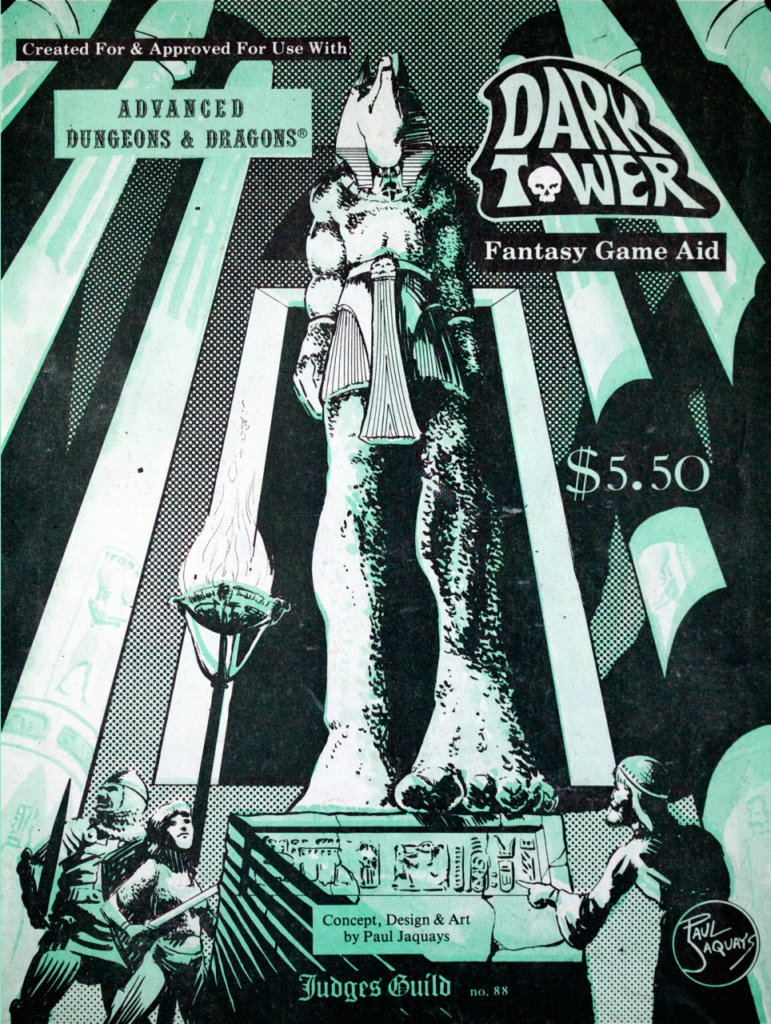
J. J.: I began thinking about the Dark Tower adventure on my long drive back from my hiring interview with Judges Guild in October of 1978. Judges Guild was in Central Illinois, I lived (and would continue to live) in southern Michigan, about 45 minutes by highway west of Ann Arbor. Until that point, “Night of the Walking Wet” in the Dungeoneer had been the largest adventure that I had created for publication.
Dark Tower was designed around three basic themes. 1.) The towers, a pair that had appeared adjacent to each other as part of a war between Set and Mitra and then been buried. 2.) The denizens of each had tunneled out to create the maze space between them. 3.) The conflict between the two was patterned after the Conan story “Red Nails” in which two opposing factions are trapped (largely by their own choices) inside a restricted space to fight each other eternally. And then we go back to Set and Mitra, two gods from the Conan the Barbarian mythos (nearly all relevant details taken from OD&D Gods, Demi-Gods & Heroes).
I knew the over-arching design that I wanted to create…a pair of monolithic towers buried long ago and then slowly being excavated. My working procedure then, and now, was to create a map that would inspire content ideas. I adjust that as I work. Dark Tower was all about the very structured towers. The white tower which I think I imagined like the Leaning Tower of Pisa in Italy, and the Dark Tower which in my mind was a massively squat black Egyptian Obelisk (think the Washington Monument, but stocky and crafted of jet-colored stone).
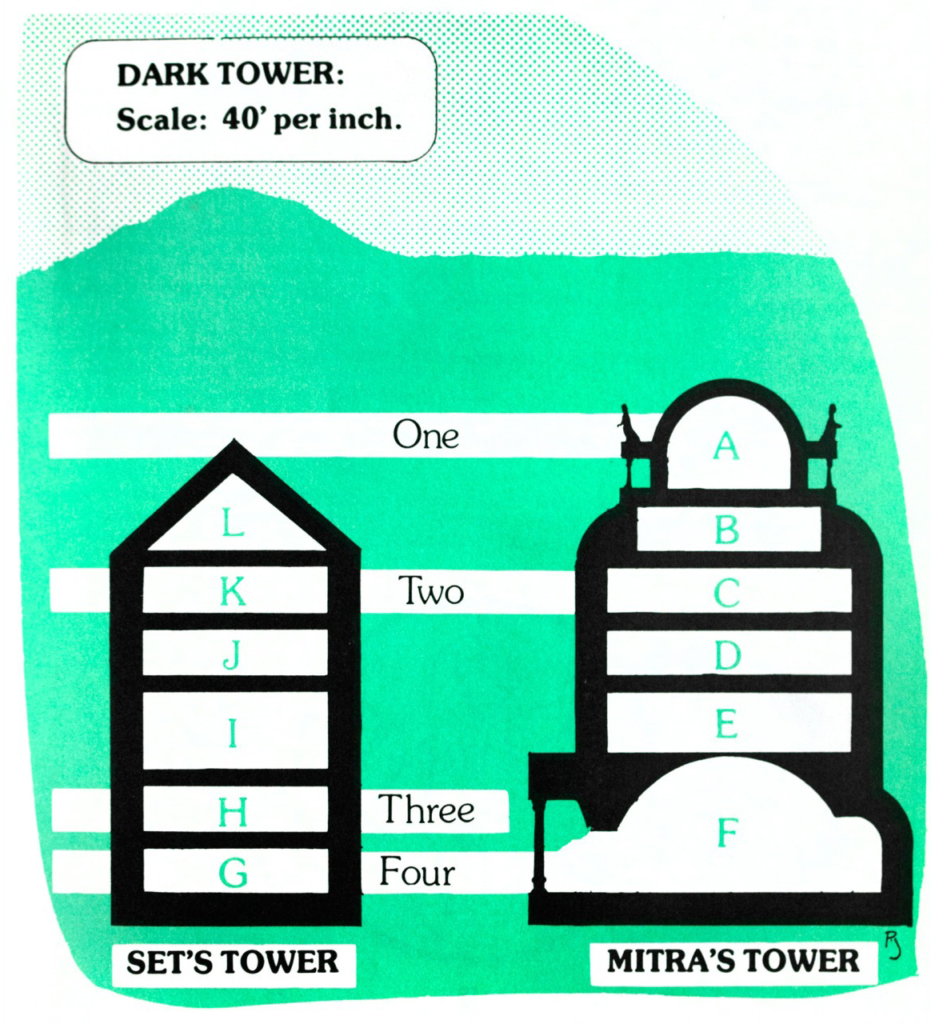
The space in between the towers was conceived as being created by “later generations” who carved out spaces and passageways to fit their own needs. This is something that plays through many of my adventure designs. The idea that spaces are built by one person or faction for their purposes and then over time, are converted or added to by subsequent residents. This is how the real-world functions. Game spaces, like real world spaces, change owners and use over time. Those changes are either easily recognized by a casual viewer, or carefully hidden by those doing the later remodeling.
I like three-dimensionality in my maps, so I am always thinking about how my maps connected vertically, including vertical spaces that cross through multiple levels of the map. That was true then. It’s true now.
When I had drawn out a map I was satisfied with, I would put it on my light box, tape a sheet of paper over it, and draw it in ink. With Dark Tower, those maps were drawn on a faux canvas paper used for oil painting. The textured area in between the rooms and halls was created by rubbing a lithographic crayon over the surface. The high points of the texture would take the black crayon an create a canvas-like pattern. Lettering, like room numbers, was added with rub-on letters.
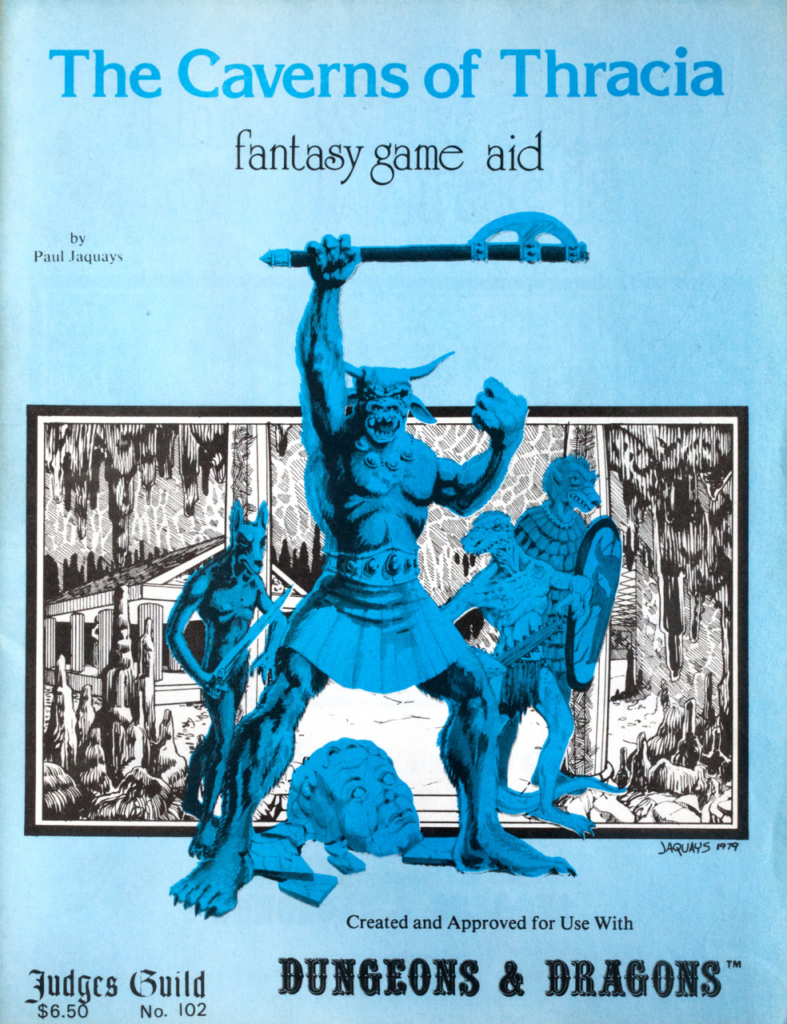
When I began designing Caverns of Thracia, which, if I remember correctly was my next adventure project after Dark Tower, I was designing for AD&D again, but at some point had to shift gears and rethink parts of it because Judges Guild was told that it couldn’t be for AD&D. This was in early 1979, I think.
Thracia centered on the ideas of an initially low-level dungeon adventure that assumed that the characters leveled up as they went deeper. I knew where I wanted to end up, in the underground double page spread forest and palace map. The maps were designed to convey the idea of a natural cave with many constructed spaces coming off of the main cavern. Sometimes, while designing, an inspiration would come for ways to expand upon an idea and a single room would expand into a series of related rooms…a mini-dungeon or side quest.
Judges Guild wanted me to write more game adventures, but they also wanted me to do cover and illustration work for a lot of products that weren’t mine. There was only so much available time in that year I worked for them.
I think Judges Guild hoped Thracia to be much smaller than it ended up being (and take less time to design). In later years (the late ‘80s), when I was writing and editing freelance for TSR, they would impose strict word and page counts on projects. They had word-to-printed-page ratios that made that easier to estimate. But at Judges Guild, I was mostly freestyling. I let the project decide what it would become and how low it would be. Judges Guild also never really edited anything. The author’s words went straight to typesetting. What you see in the printed works is pretty close to the prose I submitted to them. My manuscripts were typed on an electric typewriter on erasable onion-skin type typing paper. Final manuscripts were often cut-and-paste monstrosities of sections of type glued or taped to a carrier sheet rather than reorganizing and retyping the entire document.
OSR audiences seem generally enthusiastic about your adventures, but they’ve embraced Caverns of Thracia most of all. Do you have thoughts as to why Caverns appeals so strongly to that audience?
J. J.: Not really. Both adventures are filled with special spaces. In fact, someone once commented that all my spaces were “specials.” It’s possible that Caverns may be more useable. It starts out much lower level than Dark Tower. It also doesn’t depend on gods or mythologies which other DMs may not be using. This might be a better question to ask my fans.
Similarly, Dark Tower is often referenced as one of the greatest AD&D modules of all time. Why do you think it has captured folks’ imagination the way it did?
J. J.: I’m really not certain. I think it could have been that for the time, it was relatively unique. It was quite different from what both Judges Guild and TSR were creating. I described opponents who were interesting characters themselves and not just sets of stats or common tropes. I’m certain that I had the benefit of when my adventure was created. It might not have had the same level of appreciation if it had been introduced recently.
Do the popular legacies of these modules surprise you at all?
J. J.: Yes. These modules are over 40 years old and still in print. That’s rare in itself for any form of media. I don’t even consider them my best adventure work.
Both display design choices I strongly associate with your work, specifically A. large, complex spaces with lots of options for exploration and B. many interesting NPCs that form up various rival factions (it suddenly occurs to me that these aren’t so different, as they’re both quandaries of navigation, one physical, one social). What is it about these things that appeals to you? And, do you feel that in 1979 there were any particular things that led you to wanting to play around with them?
J. J.: One of the things I like most in adventures games, whether they are tabletop or computer First Person Shooters and MMORPGs, is exploring and discovering new places. Included in that is incorporating elements of real-world architecture into the spaces that I create. The other thing I really enjoy is creating interesting characters (My Central Casting books are still some of my favorite projects). I think both may have been an attempt to make adventures that felt more like stories than places to just kill monsters and grab their loot.
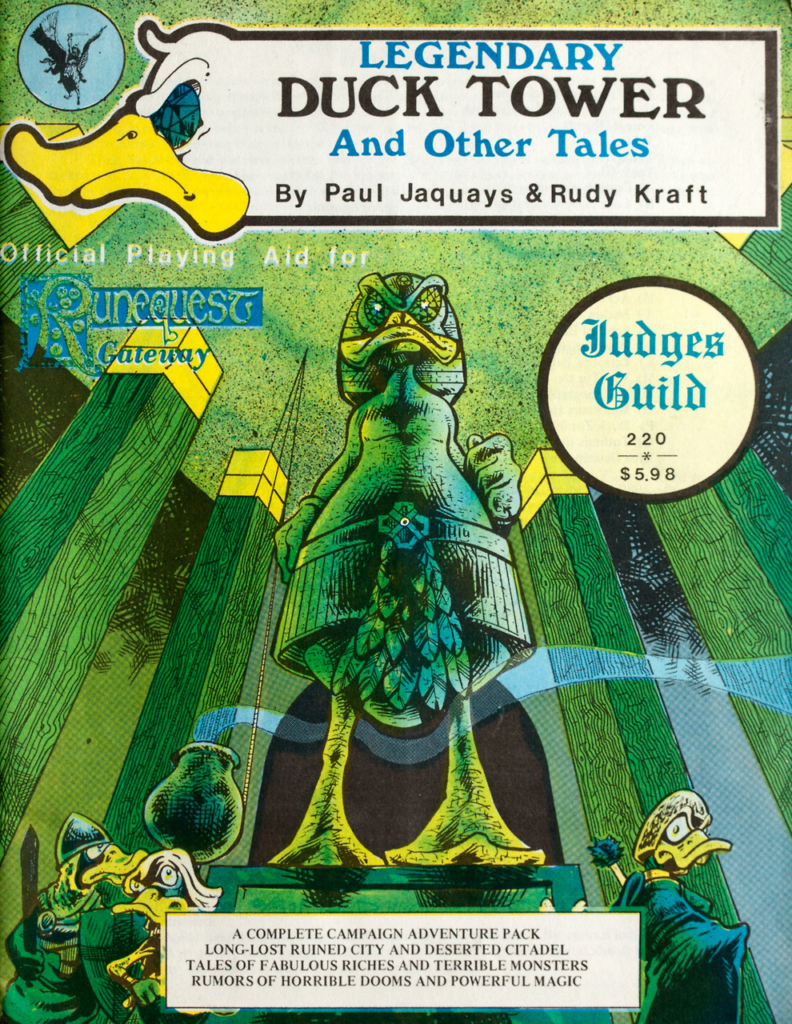
As a firm partisan of RuneQuest ducks, I feel like Duck Tower doesn’t get nearly enough attention, especially since I think it stands as equal in quality for RQ as Dark Tower does for D&D. Can you tell me a bit of how Duck Tower came to be? Was it intended as parody? Do you have any insight into why people seem to dislike RQ ducks so much? Was it difficult to switch over to a completely different system?
J. J.: Duck Tower (actually Legendary Duck Tower and Other Tales) was my last adventure project for Judges Guild. I had started it before going on vacation in the fall of 1979. The vacation was a cross-country road trip with two of my college friends that included stops at Chaosium near Berkeley, Disneyland and three days of hiking into and out of the Grand Canyon. It was a confidence building trip, and when I came back, I decided to quit my job at Judges Guild. That’s mostly for context and is not really about Duck Tower. RuneQuest was the RPG I was involved in as a player and DM at the time. I was also playing AD&D, but not running adventures any more.
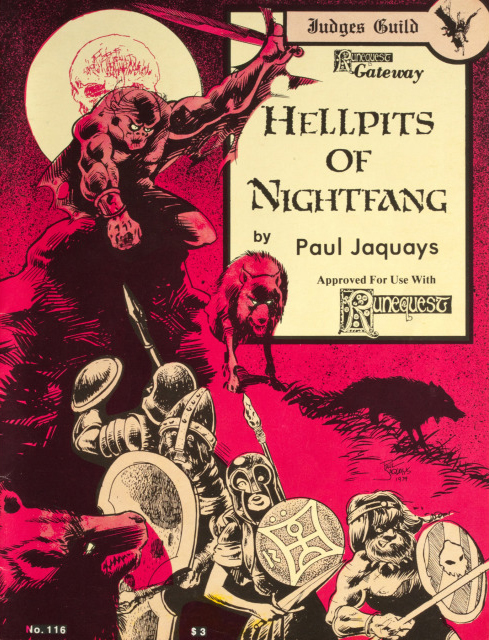
I had recently finished the RuneQuest adventure called Hell Pits of Nightfang for Judges Guild. I wanted to do another. And I liked ducks as characters. They helped make RuneQuest unique for me. My original idea for the module was to create a set of ruins that could be flex keyed. I created the encounters, but it was up to the GM to place them where they wanted in the ruins. My original idea was a grand ruin with multiple levels connected by aerial bridges. In the end, I ran out of time to develop that properly.
When I turned in Duck Tower, it was unfinished. That’s why Rudy Kraft is my co-author. He finished developing the setting. At this point, I’m not exactly sure what is Rudy’s and what is mine in the text. The map and cover are all me. As are the “Found Objects.” Rudy had a particular knack for creating good RuneQuest character stats, which was one of my weaker skills. Even back then, I depended a lot on other’s pre-created stats for my characters and creatures. That was why we collaborated so well on a later project, Griffin Mountain. He could make good stats, but I could create interesting characters. Looking at the book, I can say that my characters include the ogre adventurers, Bert the Troll and Gurgy, the Band of Broos, and possibly Vuo’Tur the Vampire.
The only aspects of Duck Tower that are parody are the name and cover art. Both were inspired by Dark Tower. Later on, John Kovalic would create his comic Dork Tower’s name based on Duck Tower.
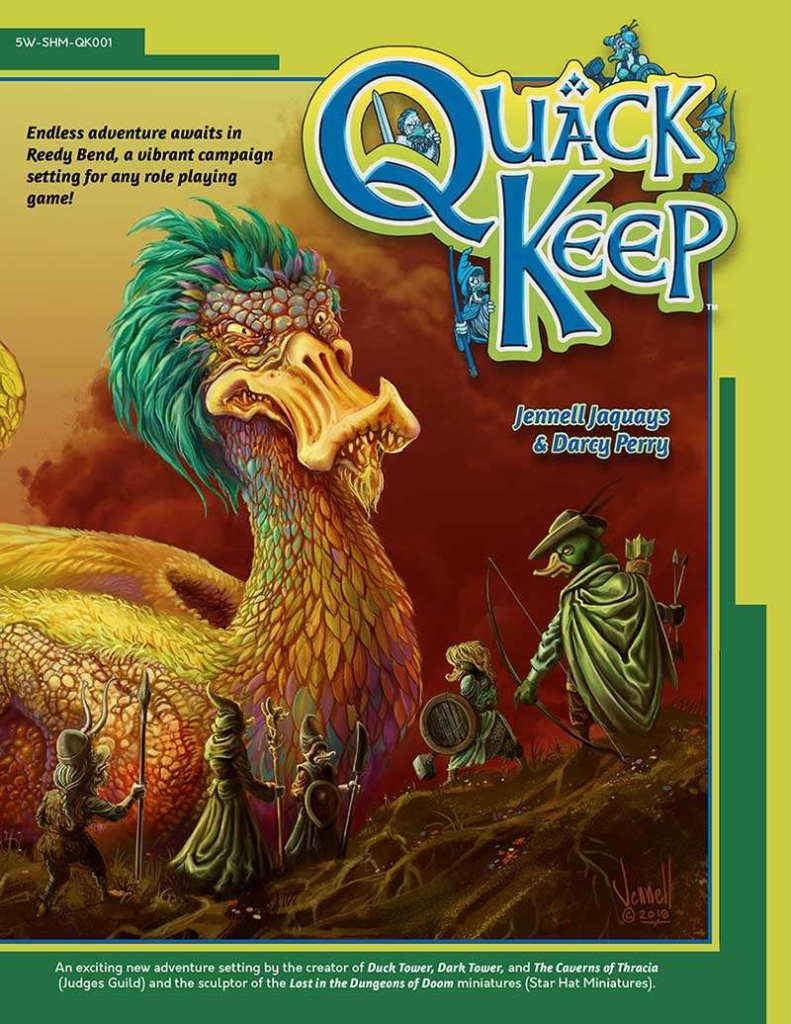
I don’t know why people hate ducks in games. Maybe they’re the same people who think fantasy RPGs should be deadly serious. The one review I have of Quack Keep on Drive Thru is hating on the humor in the book. Which again, is actually full of serious content. Just written in a humorous way.
Finally, a general, speculative question I am asking everyone I interview for this project: Do you think that RPGs were inevitable? If Dungeons & Dragons was never created for whatever hypothetical reason, do you see yourself or someone else eventually coming up with something along those lines? Or was Dungeons & Dragons a unique catalyst?
J. J.: I’m not sure. Typically, with “inevitable things,” particularly inventions, there are often simultaneous inventions going on. It becomes a matter of who publishes or popularizes things first as to who gains fame or notoriety as the inventor. In this case, you had several wargamers who knew each other creating characters that could be role played as a part of fantasy tabletop wargames. The whole hobby grew as a tree from the seed that Gygax, Arneson and David Wesley planted and tended there in Minnesota and Wisconsin. Every other RPG after that was a response to Dungeons & Dragons.
Would a Ken St. Andre have created Tunnels & Trolls without Dungeons & Dragons paving the way? Probably not. But would someone in the orbit of Greg Stafford and Chaosium have eventually created a fantasy RPG? I think that’s entirely possible. Interest in heroic fantasy was already on the rise in the early and mid-‘70s, otherwise there would not have been Conan the Barbarian or Fafhrd and the Gray Mouser comic books for me to find while in high school. There were other creative minds at work in the mid-‘70s, many who had already been “role-playing” as the leaders of nations in the game Diplomacy, or being involved as faction leaders in play-by-mail games. It was a child waiting for the right parents to come along and give birth to it.


Thanks for sharing! What a great loss to the industry. I’m glad you got to speak to her for the book.
Great interview, Stu. I love these questions and Jennell’s comments on humor in adventure design. I ran Caverns of Thracia a few years ago and it deserves every bit of the legacy.